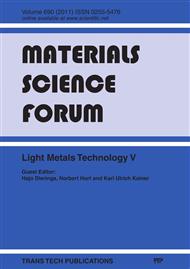[1]
Bhav Singh, B.; Balasubramanian, M.: Processing and properties of copper-coated carbon fibre reinforced aluminium alloy composites. Journal of Materials Processing Technology 209 (2009) 2104–2110
DOI: 10.1016/j.jmatprotec.2008.05.002
Google Scholar
[2]
Chen, H.; Alpas, A.T.: Wear of aluminium matrix composites reinforced with nickel coated carbon fibres. Wear 192 (1996) 186-198
DOI: 10.1016/0043-1648(95)06795-7
Google Scholar
[3]
Sobczak, N.; Kudyba, A.; Siewiorek, A.: Effect of oxidation and testing condition on wetting behaviour and interfaces in Al/Ni systems. International Conference Cast Composites 2009 (CC'2009), Kocierz, 49-50
Google Scholar
[4]
Urena, A.; Rams, J.; Escalera, M.D.; Sanchez, M.: Effect of copper electroless coatings on the interaction between a molten Al–Si–Mg alloy and coated short carbon fibres. Composites: Part A 38 (2007) 1947–(1956)
DOI: 10.1016/j.compositesa.2007.02.005
Google Scholar
[5]
Vijayaram, T. R.; Sulaiman, S.; Hamouda, A. M. S.; Ahmad, M. H. M.: Fabrication of fiber reinforced metal matrix composites by squeeze casting technology. Journal of Materials Processing Technology 178 (2006) 34–38
DOI: 10.1016/j.jmatprotec.2005.09.026
Google Scholar
[6]
Sobczak, J.; Sobczak, N.; Asthana, R.; Wojciechowski, A.; Pietrzak, K.; Rudnik, D.: Atlas of cast metal-matrix composites structures. Published by Motor Transport Institute; Warsaw, and Foundry Research Institute; Cracow, (2007)
Google Scholar
[7]
Sevik, H.; Can Kurnaz, S.: Properties of alumina particulate reinforced aluminium alloy produced by pressure die casting. Materials and Design 27 (2006) 676–683
DOI: 10.1016/j.matdes.2005.01.006
Google Scholar
[8]
Ballmes, H.; Rottmair, C.A.; Singer, R.F.: Carbon long fibre reinforced Al-matrix composites by high pressure die casting. International Conference Cast Composites 2009 (CC'2009), Kocierz, 58-59
Google Scholar
[9]
Demir, A.; Altinkok, N.: Effect of gas pressure infiltration on microstructure and bending strength of porous Al2O3/SiC-reinforced aluminium matrix composites. Composites Science and Technology 64 (2004) 2067–(2074)
DOI: 10.1016/j.compscitech.2004.02.015
Google Scholar
[10]
Daoud, A.; Abou El-khair, M.T.: Wear and friction behaviour of sand cast brake rotor made of A359-20 vol % SiC particle composites sliding against automobile friction material. Tribology International 43 (2010) 544-553
DOI: 10.1016/j.triboint.2009.09.003
Google Scholar
[11]
Hufenbach, W.; Gude, M.; Czulak, A.; Engelmann, F.; Boczkowska, A.: Textile-reinforced carbon fibre aluminium composites manufactured with gas pressure infiltration methods. International Conference Cast Composites 2009 (CC'2009), Kocierz, 56-57
Google Scholar
[12]
Kozera, R.; Dolata-Grosz, A.; Sleziona, J; Dyzia, M.: Bielinski, J.; Broda, A.; Boczkowska, A.; Kurzydlowski, K. J.; Gude, M.; Czulak, A.; Engelmann, F.; Hufenbach, W.: Investigations of the interfaces between carbon fibres and an aluminium alloy matrix in composites fabricated by the pressure infiltration process. International Conference Cast Composites 2009 (CC'2009), Kocierz, 60-61
DOI: 10.4028/www.scientific.net/amr.264-265.1487
Google Scholar
[13]
Dyzia, M.; Dolata-Grosz, A.; Śleziona, J.; Hufenbach, W.; Gude, M.; Czulak, A.: Infiltration Test Of Carbon Fibres Textile By Modified AlSi9Cu(Fe) Alloy. Composites 9 (2009) 3; 210-213
Google Scholar
[14]
Sobczak, N.; Kudyba, A.; Siewiorek, A.; Sleziona, J.; Dolata-Grosz, A.; Dyzia, M.: Bielinski, J.; Kozera, R.; Boczkowska, A.; Kurzydlowski, K. J.; Ballmes, H.; Rottmair, C.A.; Singer, R.F.; Gude, M.; Czulak, A.; Engelmann, F.; Hufenbach, W.: Factors affecting wettability and infiltration of 3D Reinforcement with liquid Al-based matrix. International Conference Cast Composites 2009 (CC'2009), Kocierz, 62-63
Google Scholar
[15]
Etter, T.; Schulz, P.; Weber, M.; Metzc, J.; Wimmler, M.; Löffler, J.F.; Uggowitzer, P.J.: Aluminium carbide formation in interpenetrating graphite/aluminium composites. Materials Science and Engineering A 448 (2007) 1-6
DOI: 10.1016/j.msea.2006.11.088
Google Scholar
[16]
Kammer, C.: Aluminium Taschenbuch Band 1. Grundlagen und Werkstoffe (15. Auflage). Aluminium-Zentrale Düsseldorf (1998)
Google Scholar


